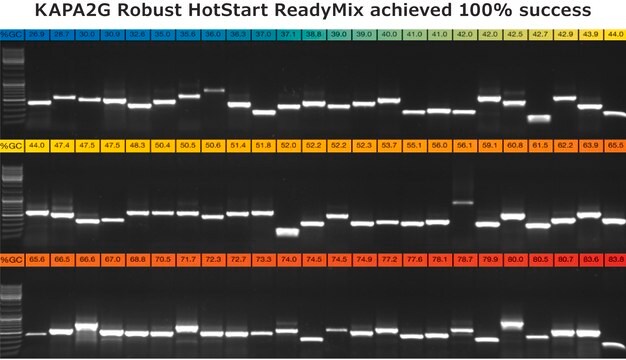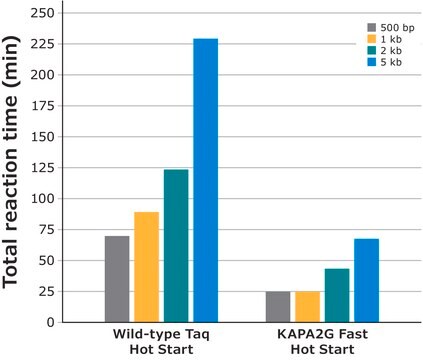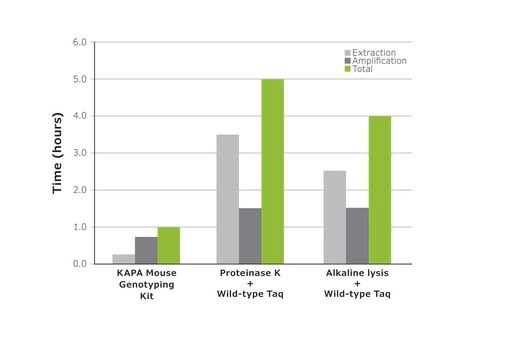2GRKB
Roche
KAPA2G Robust PCR Kit
Sinonimo/i:
PCR
About This Item
Prodotti consigliati
impiego
sufficient for 200 reactions
sufficient for 500 reactions
Livello qualitativo
Durata
≤12 mo.
Caratteristiche
Difficult Templates/Specialty Enzymes PCR
dNTPs included
hotstart: no
Confezionamento
pkg of 100 U (KK5023)
pkg of 250 U (KK5024)
Produttore/marchio commerciale
Roche
tecniche
PCR: suitable
input
crude DNA
Temperatura di conservazione
−20°C
Cerchi prodotti simili? Visita Guida al confronto tra prodotti
Descrizione generale
The enzyme is supplied with three reaction buffers, and a proprietary enhancer for GC-rich PCR. KAPA2G Buffer A is specifically formulated for the unique characteristics of the engineered KAPA2G enzymes, while KAPA2G Buffer B is recommended when template samples are contaminated with PCR inhibitors. KAPA2G GC Buffer is recommended for GC-rich PCR, while KAPA Enhancer 1, a proprietary DNA destabilizer, may be combined with either KAPA2G Buffer A or B in GC-rich assays, or assays where secondary structure is problematic.
Applicazioni
- Amplification of GC- or AT-rich templates and gene amplification
- Templates containing common PCR inhibitors e.g. salts, urea, SDS, or ethanol
- Crude sample PCR e.g. buccal swabs, cultured mammalian, yeast, or bacterial cells
- Colony PCR
- Routine PCR
- PCR amplification
- Avipoxvirus specific PCR
- Simplex PCR
- Semi-quantitative PCR
Azioni biochim/fisiol
Caratteristiche e vantaggi
- Robust performance across a wide range of GC- and AT-rich templates
- Increased PCR success rates
Improved tolerance to common PCR inhibitors
- Efficient amplification from crude samples
- Higher yield and sensitivity per unit of enzyme
Unrivalled performance in colony PCR
- Higher yields and improved consistency of PCR direct from E. coli and yeast cells
Quick Notes:
- KAPA2G Robust PCR Kits contain KAPA2G Robust DNA Polymerase, engineered for high processivity and inhibitor tolerance.
- Both purified genomic DNA and crude samples (e.g. colony PCR) can be used as template.
- Use 0.5 U of KAPA2G Robust DNA Polymerase per 25 μL reaction. More challenging PCRs (GCrich,crude sample) may require higher enzyme concentrations.
- Use 15 sec/kb extension time per cycle, and increase to 30–60 sec/kb for difficult amplicons or templates.
- KAPA2G Buffers contain 1.5 mM MgCl2 at 1X.
- Additional MgCl2 may be added using the 25 mM MgCl2 solution provided in the kit.
- KAPA2G Buffer A is optimized for high yield, specificity, and sensitivity.
- KAPA2G Buffer B is recommended for inhibitorcontaminated template samples.
- KAPA2G GC Buffer is recommended for GC-rich PCR (>70% GC).
- KAPA Enhancer 1 can be used with KAPA2G Buffer A or B, particularly for GC-rich assays.
- Reaction products are 3′-dA-tailed and may be cloned into TA cloning vectors.
Qualità
Nota sulla preparazione
Altre note
Solo come componenti del kit
- KAPA2G Robust Standard or HotStart® DNA Polymerase 5 U/μL
- 5X KAPA2G Buffer A with MgCl2
- 5X KAPA2G Buffer B with MgCl2
- 5X KAPA2G GC Buffer with MgCl2
- 5X KAPA Enhancer 1
- MgCl2 25 mM
Avvertenze
Warning
Indicazioni di pericolo
Consigli di prudenza
Classi di pericolo
Acute Tox. 4 Oral - Aquatic Chronic 3 - STOT SE 2
Codice della classe di stoccaggio
12 - Non Combustible Liquids
Classe di pericolosità dell'acqua (WGK)
WGK 1
Punto d’infiammabilità (°F)
does not flash
Punto d’infiammabilità (°C)
does not flash
Certificati d'analisi (COA)
Cerca il Certificati d'analisi (COA) digitando il numero di lotto/batch corrispondente. I numeri di lotto o di batch sono stampati sull'etichetta dei prodotti dopo la parola ‘Lotto’ o ‘Batch’.
Possiedi già questo prodotto?
I documenti relativi ai prodotti acquistati recentemente sono disponibili nell’Archivio dei documenti.
I clienti hanno visto anche
Articoli
An overview of directed evolution and the methods for generating proteins with optimized or entirely new functions.
Il team dei nostri ricercatori vanta grande esperienza in tutte le aree della ricerca quali Life Science, scienza dei materiali, sintesi chimica, cromatografia, discipline analitiche, ecc..
Contatta l'Assistenza Tecnica.





